Nomads, she’s here!
On 17 October 2019 we finally welcomed our long awaited rainbow baby, Maika Rei.

She’s 12 weeks old now, if you can believe it? If you follow us on Facebook, you’ll already know this, but we haven’t shared the news here yet, or had the chance to tell you about her birth story.
The last time I wrote about the pregnancy was one day before my due date, when we were waiting for things to happen “any day now”. Even though it was unlikely she’d come exactly on the due date, I thought she might come very close to it since I was having lots of pre-labour symptoms and, well, it really was only a matter of time.
I remember thinking at my hospital appointment at 38 weeks and 5 days that I might not need my next appointment a week later. Then another week passed and she still hadn’t arrived. And then a week after that and we were still waiting. It’s funny to think that I thought she might come early, when now I was officially past my due date and the doctors gave me a grin as I waddled in, “Still here, are we?”
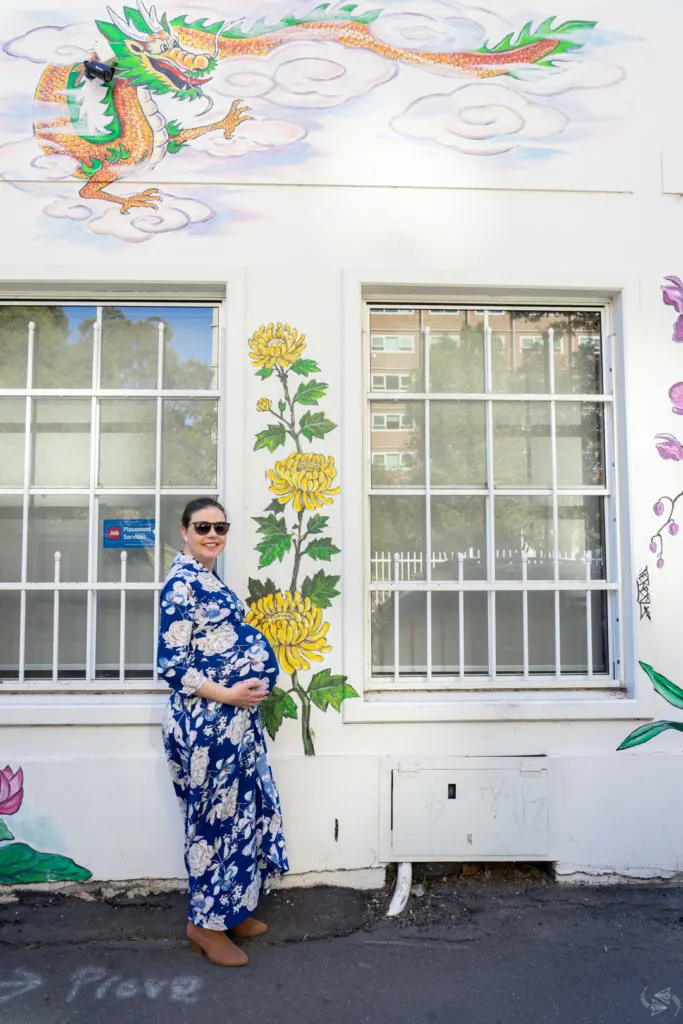
When I reached my 40 week and 5 day appointment, instead of the regular check-up, I was booked in for a scan that goes for up to an hour and sees what the baby is up to (heartbeat, movement etc), and to see the induction midwife. At the hospital I was going to, they consider you overdue at 40 weeks and 10 days, and they generally want to induce you at that point.
So in case I didn’t go into labour on my own before then, I was booked in for induction for 5 days later. After my internal examination, however, the induction midwife believed that my body had already “done much of the work” and that she thought it highly unlikely that I would make it to the induction day. She did a ‘stretch and sweep’ of the membranes to try to get things moving, which was actually really painful. The baby was so low that she could feel her head with her fingers! Afterwards it was a similar feeling to after a pap smear.
Table of Contents
The phone call
That evening I got a call from the hospital at 7:40pm. Apparently doctors review all the scans after the fact to double check everything is OK. I was told earlier in the day that my scans were normal so you can imagine how much my heart dropped when the person on the other end of the line said, “Now, I don’t want to alarm you, but can you get back to the hospital by 8:30pm? While your baby did appear to be active while awake, we’re concerned your baby wasn’t awake for long enough periods. We want to do the scan again and depending on that result we may need to move on the induction more quickly.”
We quickly rushed to the hospital and I was once again back on the same bed I was on earlier that morning, only this time in addition to the monitors on my stomach, they had me push a button every time I felt the baby move.
This part was like the old saying about watching a kettle boil. But while there were some anxious moments there where it felt like a lifetime since she last kicked, once she got going there was lots of movement and they were satisfied that the baby was still safe to stay in the womb a little longer.
More pre-labour signs
By later that evening I started to lose the mucous plug, a normal and essential pre-delivery step, although not every pregnant women notices when it happens. The mucous plug is the barrier that essentially seals the cervix during pregnancy to keep the baby protected from any harmful bacteria. While that didn’t necessarily mean labour was imminent (some people lose theirs and don’t go into labour for another couple of weeks), given I was already past the due date and I had had the stretch and sweep earlier in the day, it was likely that labour was now nearing very close.
I thought I’d lost all of it (the mucous plug that is) as there was nothing more the following morning and day. However, in the evening there appeared to be more and I had more of a “show”, a pink or brown blood-tinged mucus as a result of blood vessels in the cervix rupturing as it begins to efface and dilate. I found this part of pre-labour to be oddly fascinating and not something I had known about before being pregnant, and doing some reading and attending childbirth education classes.
I spent that evening finishing up and publishing my post about my miscarriage in late 2018 (another reason why the call from the hospital the night before had been quite scary). It was a deeply personal story that has taken me a long time to post and I truly believe that Maika was waiting for me to tell my truth and release myself from the burden of that internal struggle before she came.
Because just a couple of hours later on October 16th at 11pm, the contractions started. Just as I had predicted, even after many weeks of Braxton Hicks and wondering when things would get started, I did know “this was it”.
The labour begins
From the childbirth education classes, I knew that the contractions might be very irregular and quite far apart to begin with. However, they were a steady 10 minutes apart right from the outset and it wasn’t long before they were 8 minutes and then less. I laboured at home all night.
I called the hospital at 6:44am (I checked my phone records!) and got an automated message saying the midwife on duty was on another call and to call back later. I called again at 6:53am and got through. I was dismissed because “it was my first child” and told to stay home.
I called again at 8:11am and once more got the same automated message. My contractions were consistently 3-4 minutes apart and Hai and I decided to get in the car to start making our way to the hospital, rather than waiting to get through again. I called again on the way and they still didn’t think I should come in. But I said that I was concerned about the baby’s movements and then they had to allow me to come in for a check.
When we reached emergency, I had a couple of contractions in the time they were asking me questions to assess my progression, then another as I waited to be seen, and it was only then that I was taken to a room to be assessed internally. “Have you been labouring all night?” she said aghast. She was the receptionist who had seen me at the front desk. She assured me that she and the others in the office are also trained midwives and that they could help deliver the baby then and there if necessary.
After that, she went to the office adjoining the room to make a call. The person on the other end wanted to send me back home but I could hear the midwife who assessed me saying that she didn’t think that would be the best course of action. “I think this is a birthing suite situation,” she pressed.
Nowhere to go…
The only problem was they didn’t have a birthing suite available. All twenty were currently in use. She knew that in my birth plan (which was in my file) that I wanted to do water immersion for pain management, so she arranged for me to go into the only room they had: the isolation room.
“While I can’t give you a birthing suite at the moment,” (which has a bath and the whole swathe of facilities for birth), “I can at the very least offer you a shower,” which this room had. So I spent the next couple of hours under the shower. No midwife. No epidural. And while an epidural wasn’t a part of my birth plan, I couldn’t get one in that room even if I decided I wanted one.
The biggest problem with this room being the isolation room – i.e. the place they send you if they think you might have something contagious – was that (for obvious reasons) there was absolutely no ventilation. No air conditioning, no air movement, no windows. Hai was moving the door to the bathroom back and forth to try to create a small breeze.
Finally we got word that I would be able to be moved up to the birthing floor, several floors up from the lower ground floor I was currently on. They asked if I wanted to walk; I opted for the wheelchair. The elevator was about to close, but thankfully the midwife asked if we could squeeze in and someone held the door. Hai was carrying the hospital bag and I recall the man behind us saying to him, “You’ve got the easy job.” And then, “Good luck, guys,” as we exited on the birthing level. I distinctly remember feeling a bit scared about what was to come at this point.
As I was pushed through the double swing doors to the birthing suites, my mind was brought back to our tour of this very floor during one of our childbirth education sessions. While we were looking at a birthing suite, a labouring woman was pushed into the suite next door while mid-contraction and all the mums-to-be exchanged looks of mild panic. Now I was that woman.
While I was now on the birthing floor, I wasn’t actually in a birthing suite. I was assured they were working on it and I’d be moved to one as soon as possible. A couple of midwives ducked in to check on me from time to time – but as there were many women in labour, they didn’t have anyone spare to stay with me.
When there was a change of shifts in the afternoon, I was finally designated a midwife and it was she who ended up being with me until the birth. Thinking that the birthing suite wouldn’t be too far away, she didn’t run a bath, trying to save me the hassle of getting in and then having to get out. So instead we got back in the shower.
In the throes
The next few hours were a bit of a blur. On all fours in the shower. On all fours on the hospital bed. The midwife using a mirror to assess my progression.
The latter stages of labour were other-worldly in a way. I was both fully aware of the pain and also in a kind of primal trance, where I was so focused that I wasn’t always aware what was going on around me.
I remember during one contraction though Hai trying to help me by applying counter pressure to my back, a technique we had learned during childbirth education classes. The support partners were warned that they’d likely be up for hours and hours of massage. Typically one to like massage, I thought that was going to be one of the methods I would be relying on most. Yet when it came to the labour I didn’t want to be touched. It didn’t help me with the pain and perhaps even made it a little worse, mostly because it was distracting me from the task at hand. At the height of the contraction I couldn’t speak, but on the way down I was able to summon the energy to raise my hand to say “Please stop” and I think I shook my head a little too.
I also remember the midwife’s voice, even though I was so in the zone I couldn’t physically see her. But hearing her say, “Yes, Jess!” when I was making headway made me feel like we were getting somewhere. “8cm dilated,” she said at one point, then “Fully dilated” at another.
“I can see your baby’s head. Don’t let your baby slip back, Jess” I could hear her saying in a motivating way. We tried and tried, but the baby just wasn’t in the right position. Earlier in the shower she informed me that the baby wasn’t in full breech position, but her head was tilted far back and her spine wasn’t quite facing the way it should be. It wasn’t ideal but it didn’t necessarily mean I couldn’t have a vaginal birth; we’d have to play it by ear.
Time to push
There wasn’t a distinct moment in time when it was declared it was “time to push,” but one contraction I just recall the midwife telling me to and I suddenly wondered if I was nearing the end.
After a couple of hours of pushing, the baby wasn’t able to “round the corner”, as they say. In between contractions, the midwife said something that made me feel really seen and comforted. “You’re pushing like this is your fifth kid. Seriously. It’s freakin’ amazing. I swear, if you ever decide to have a second kid, that baby will be out so fast.”
Suddenly a swarm of specialists and nurses came flooding into the room. The midwife was quickly by my side. “Jess, I know this is scary seeing all these people coming into the room. But you’re OK. Everyone is here to make sure you and your baby are safe.”
I was now on my back on the hospital bed, not really remembering when I changed positions. “We’ll need to break her waters.” “Jess, we need to know what’s going on with your baby. Would it be OK if I put a clip on your baby’s head?” said the specialist now at the end of the bed. I nodded. My gaze made its way to the clock on the wall behind him, the first time I had noticed the time since arriving. It was now 5pm.
Then I heard the voice of another doctor to my left. “Try not to worry. It’s just that sometimes it’s difficult for us to distinguish between your heartbeat and the baby’s heartbeat. This happens quite often. We just need to be sure what’s going on.” I recognised this doctor as the obstetrician I had seen a few weeks earlier during my scheduled clinic visit. Even though I had only met him once, it was nice to see a familiar face.
At the next contraction, the specialist looked me straight in the eye and told me to give it all I had. At the conclusion of the contraction, he shook his head in the midwife’s direction. “Nope. The baby’s not going to come out in this position. We’ll try just one more contraction, but I think we’ll have to intervene.”
At the next contraction, the baby was still unable to proceed any further down the birth canal. We were told that they would need to use forceps to try to “flip the baby”, only it was too dangerous to perform in that room. They’d need to take me to theatre for that and they’d have me prepped ready for an emergency c-section if necessary.
Once that decision had been made, the specialist and his large entourage swiftly vacated the room. “Did they break her waters?” Hai asked the midwife, since discussion of it ceased once he’d examined me. “No, they must have broken in the shower.”
Looking back, I can pinpoint the exact moment it happened with the massive ‘pop’ that accompanied it – the pressure was just incredible. Yet at the time it strangely didn’t even occur to me that that was my waters breaking. Being in the shower, I didn’t feel any additional liquid, and when it happened the midwife let out a hearty, “Yes, Jess!” so I assumed whatever it was, she had seen. Having been in labour for many hours now, I’d simply forgotten about my waters and just thought this was another kind of labour sensation. On reflection it makes sense that it’s difficult for even the midwives to see visually in the shower and not everyone gets a big gush either. This ain’t the movies, that’s for sure.
Getting ready for theatre
Another midwife had come in to assist with the paperwork and was tapping away at the computer asking me questions between contractions, like when the contractions first started and when they started being “regular” (3-4 minutes apart), and when I’d last eaten.
It was only then I realised that I hadn’t really eaten anything since dinner the night before, save for the half a chocolate bar I had downed in the shower in the isolation room in the morning to give myself a little burst of energy after a long night.
A couple of people came in and out, each time saying that they were working on getting me into theatre but they were all currently occupied. I remember one nurse coming in and saying that I’d had to be bumped for an emergency c-section. The next contraction came while he was talking. In what he thought was the middle of it he said, “Ride the wave, honey. It’s on its way out now.” He looked over to the midwife who had her hand on my abdomen feeling the contraction and I could see out of the corner of my eye her shaking her head as if to say, “No, she’s not anywhere near finished yet.” He didn’t know that I’d been having contractions of several minutes in length rather than the 60-90 seconds they tell you to expect in childbirth education classes, therefore the height of the contraction was much lengthier and intense than average.
His demeanor suddenly changed to one of slight guilt. “But she’s cool to hang out here for a bit? She has an epidural, right?” Again, I saw the swift shaking of the head from the midwife. “Oh, OK,” he said in a way that indicated he finally understood that I couldn’t really (or at least shouldn’t) be bumped again, and he ran off to check on the status of the operating theatre.
Still waiting…
Hanging above the bed were my safe childbirth and health omamori (amulets) from Japan – most of them farewell and congratulatory gifts from friends. I’d strung them up together and had them hanging in the nursery at home. Despite the hospital allowing (and encouraging) bringing items from home – photos, pillowcases, lamps, diffusers – to make things feel as familiar as possible and to help the flow of the feel-good hormone oxytocin that also drives childbirth, the amulets were the only thing that I really cared about having in the room with me.
After what felt like an eternity, I said slightly wearily to Hai, “I hope it’s not going to take much longer. Do they know how much longer it’s going to take?” Hai looked over with concern to ask the midwife. She quickly came to my bedside, put her hand on my arm and empathised with me, “I know. It’s not fair. This is taking forever. I swear, under normal circumstances, with the way you’ve been pushing, you would have had your baby hours ago.”
I was told that I didn’t need to push while we waited since the baby wasn’t going to come out this way. Some time later, seeing me pushing through a contraction, Hai gently reminded me to conserve my energy, but I told him it hurt much more if I didn’t. The midwife told me to just do whatever I needed to do to get through it.
More staff came in and commented on the amulets. “I LOVE that!” one after the other exclaimed. “You can take those into theatre. We’ll put them in the trolley that the baby will be placed in.”
Time to go
It was another couple of hours before I was finally lifted onto a trolley and wheeled through the halls to theatre. I heard them say, “Cover her up, we’re going to wheel her through a public area.” A hospital gown had been placed over me at some point.
The world whipped by around me. This was the first time I’d left the room since I was wheeled into it after the isolation room stint all those hours earlier. The nurse who was at the top of the bed was speaking to me in a soothing voice. “We’re almost there now. Some day soon this is all going to be a distant memory. You’re going to meet your baby soon.”
We went through some doors and suddenly the trolley stopped and I was surrounded by more people. It seemed we were still waiting for the theatre to be quite ready. In the meantime, I was given a drink to keep my stomach settled by the midwife. “Jess, drink this. Now, I’ll be honest with you because I like you, it doesn’t taste very good.” I downed it quickly in two large gulps. A disgusting flavoured liquid seemed like small fry in the scheme of things. “Like a champ,” she said approvingly as I handed her back the empty bottle.
The obstetrician I had recognised earlier was also there. He showed me the sheet of paper I had signed when he came in to explain the risks of the procedure, which he had to do over several contractions, giving me as much information as he could before the wave of pain hit again. With the midwife as witness, he confirmed that this was indeed my signature, he showed me his and confirmed I understood everything. “Do you know what we’re going to do here today?” “Forceps delivery, possible c-section,” I said quickly and slightly out-of-breath, knowing that the next contraction would come again any second. He gave a nod to the midwife and moved away from the bedside.
“This is the last contraction you’re going to feel,” one member of staff had said preemptively while we were waiting. It wasn’t. I think I had five more before they were able to get the specialist who could give me the anesthetic into the spine laterally, meaning while I was lying on my side (apparently only one was qualified to do it). If that wasn’t an option, they would have needed to get me off the table and into a different position.
To my relief, it wasn’t nearly as bad as I thought it was going to be. In fact, apart from a little sting, it was fine. After a few moments, I felt it kind of wafting over me and down the lower half of my body. “The next contraction is coming,” said the midwife as she readied her hand over my abdomen to feel it. “She’s having the most mammoth contractions,” she conveyed as an explanatory side note to everyone in the theatre.
“Can you feel that, Jess?” “No,” I confirmed. “Yay, finally!” she said in a celebratory tone. Now when the nurse at the top of the bed, the one who had been saying those soothing things while I was being wheeled to theatre, said, “That last contraction you felt before, that’s the last one you’re going to feel,” it really was true.
The specialist from before was now back at the end of the bed. The midwife and others apologised for having to put my feet in stirrups for the delivery. It kind of made me laugh because it’s not as if you have any dignity left at this point anyway. He asked my permission to do something. I said that he could do whatever he wanted now the anesthetic had arrived. The whole theatre was laughing and the atmosphere became more jovial.
The birth
“Get dad in here,” I heard them say. I hadn’t seen Hai since we left the “birthing-not-birthing” room. He wasn’t allowed to be with me while I was being prepped for theatre and later he told me how worried he was that it had taken much longer than expected. He had wondered if there had been any trouble with the anesthetic, knowing that I often have troubles with needles getting to where they need to be (just ask any doctor or nurse who has ever tried to draw blood from my tiny veins). He was left in another room waiting in scrubs to be called in.
Suddenly, he was back by my bedside and, at the next contraction, I was instructed to lean forward and push, keeping all of the sound within so as not to let any pressure escape. I had to quickly suck in air a number of times to sustain me through the whole contraction. Then it was rest for a short time before the next one came. Some time after the second contraction, the doctor suddenly announced, “We have a baby.”
“What?” I thought. “After just two contractions?” Given the time between the second contraction and the announcement, I think he had waited to finish delayed cord clamping before he said anything. Delayed cord clamping simply means waiting until the umbilical cord stops pulsating before clamping it, which allows the baby’s blood left in the placenta (about 30%!) to be transferred to the baby. We requested this, but it is also standard practice these days at this particular hospital given the research that has now been done into its health benefits.
Then he held up our daughter high over the curtain, her head leaning slightly off to the side. Then came a moment I’ll never forget. She looked right at me and smiled.
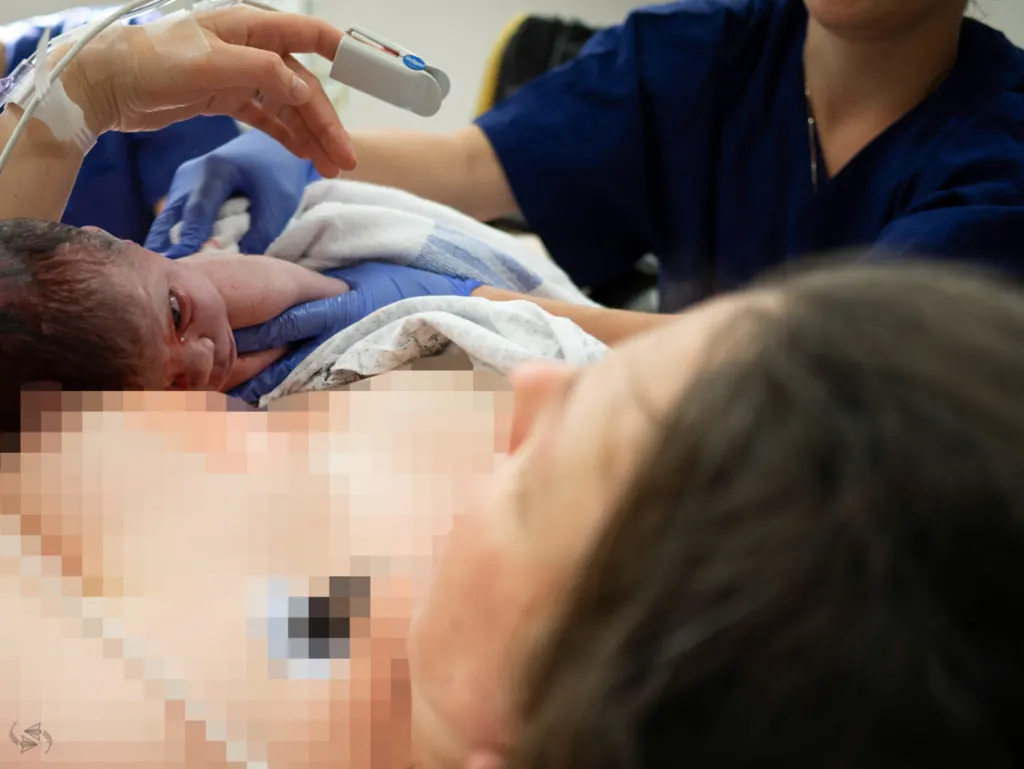
She was placed onto my chest and Hai went to cut the umbilical cord. After a few moments of hellos, I asked the midwife who was now by my side if she was OK. Her eyes were open but she was just kind of staring into space and she was very purple. “I think she’s labouring a little,” I expressed. The midwife took the baby to the resuscitaire. As I looked over, the soothing voice from above once again chimed in, “Don’t worry, they’re just giving her a little bit of oxygen. Babies can come out a little shocked at being born too.” A few moments later, we heard her cry for the first time. Tears welled up in my eyes in a kind of elated relief laugh. She was here and she was OK.
Hai was invited to cut the umbilical cord again. “Again?” he questioned. “Yeah,” said the midwife enthusiastically. “You can cut it as many times as you like!” As soon as was possible, she was returned back to my chest where she continued to cry a little more. “I know, it was quite an ordeal getting here,” I empathised with her. “You’re telling me,” said the midwife.
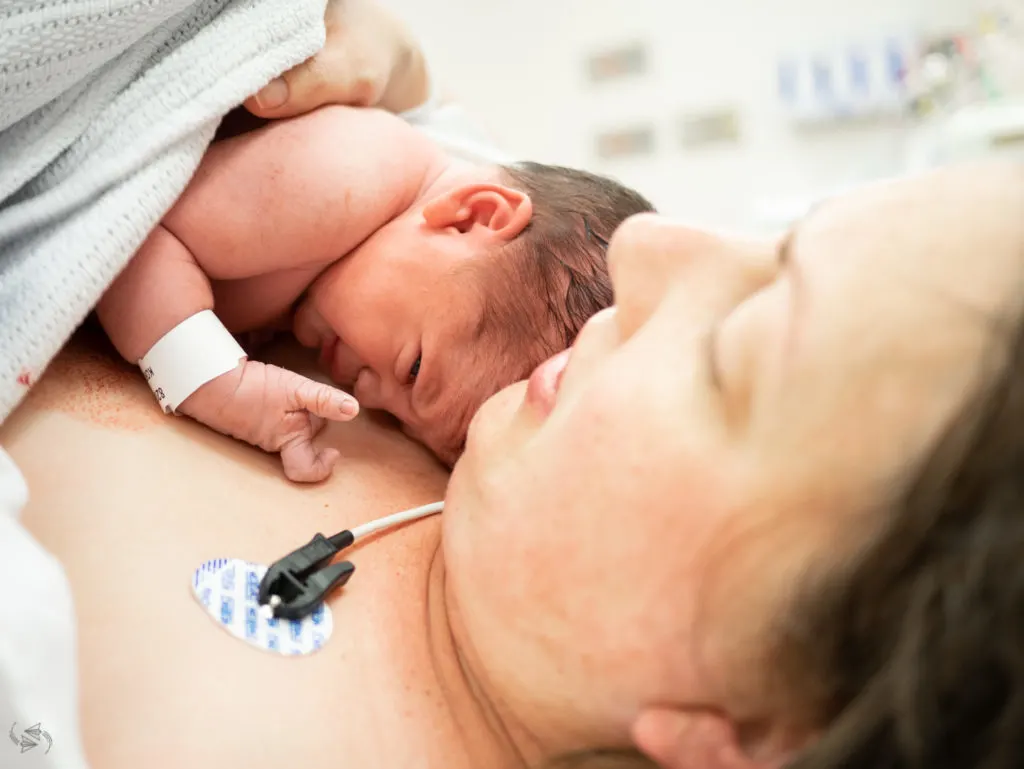
Immediately after the birth, the doctor assessed my injury as a third degree tear, despite having had an episiotomy to try to avoid as much tearing as possible. He stitched me up while our daughter lay on my chest. During that short time she was over at the resuscitaire, she already had her first bowel movement and her first vaccination. “She’s already kicking goals,” the midwife said.
Wheeled out of the theatre, I was suddenly surrounded by lactation consultants to help me with my first feed. The baby was popped onto my breast and started suckling immediately. What a strange feeling.
“Have you decided on a name yet?” “Yes, her name is Maika,” I replied suredly. Even though we had chosen it before meeting her, we already couldn’t imagine another name for her.
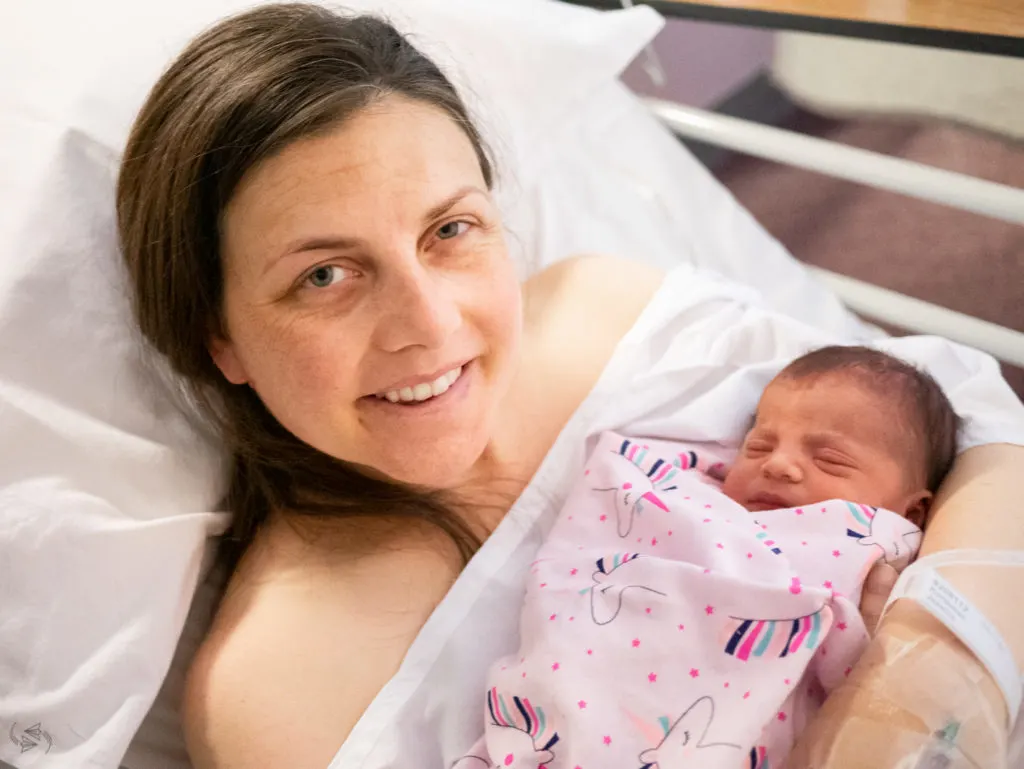
After 22 hours of labour, she had finally arrived. We had done it.
Pin me

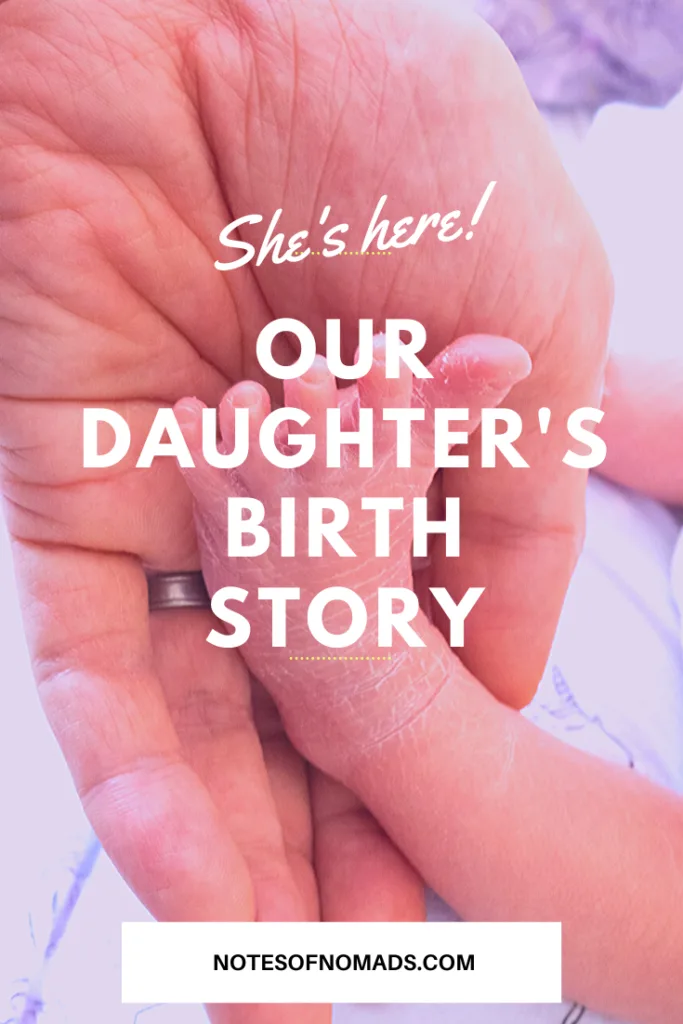
Les Petits Pas de Juls
Monday 13th of January 2020
Jess, you're a rock star! Congratulations again and may 2020 be fabulous for the 3 of you! Sending you much love and many hugs.
Thanks for sharing such an intimate moment with us; I'm sure lots of future moms will be thankful for your reality comments because they usually don't tell much at the hospital or outside and many future mom don't really know what to expect.
And it was fascinating for me to discover the inside of such a special moment in a woman's life, as I've decided I will not live it. You're one of the heroes, my friend.
Lots of love, xoxoxo Jul'
Dawn Hansford
Monday 13th of January 2020
Wow I feel exhausted now! It must have been a very traumatic time, so pleased all went well!